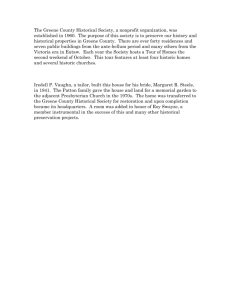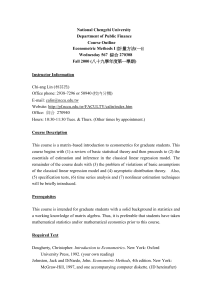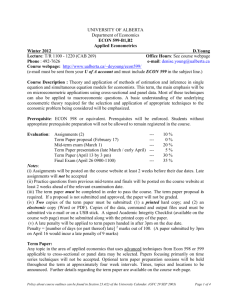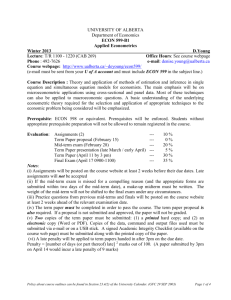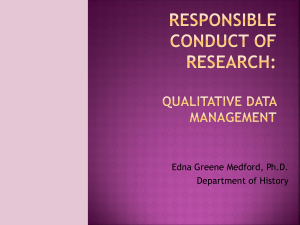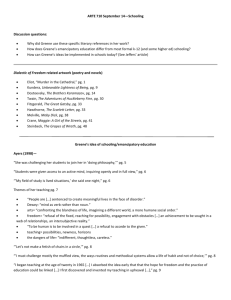ECON 4160 ECONOMETRICS
advertisement
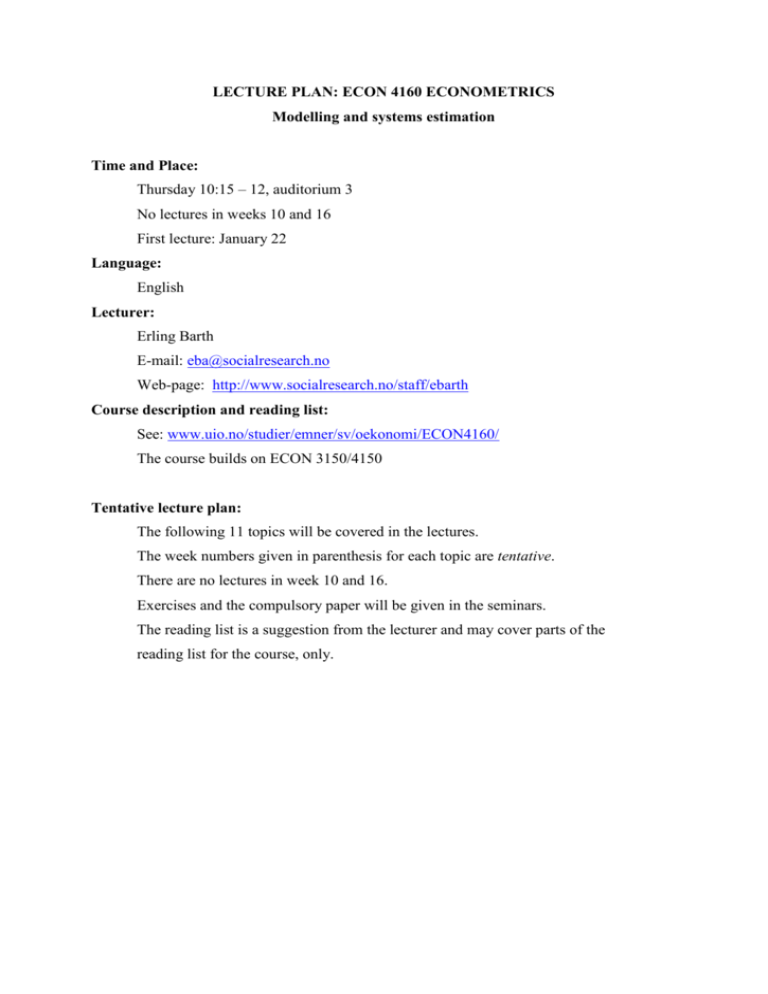
LECTURE PLAN: ECON 4160 ECONOMETRICS Modelling and systems estimation Time and Place: Thursday 10:15 – 12, auditorium 3 No lectures in weeks 10 and 16 First lecture: January 22 Language: English Lecturer: Erling Barth E-mail: eba@socialresearch.no Web-page: http://www.socialresearch.no/staff/ebarth Course description and reading list: See: www.uio.no/studier/emner/sv/oekonomi/ECON4160/ The course builds on ECON 3150/4150 Tentative lecture plan: The following 11 topics will be covered in the lectures. The week numbers given in parenthesis for each topic are tentative. There are no lectures in week 10 and 16. Exercises and the compulsory paper will be given in the seminars. The reading list is a suggestion from the lecturer and may cover parts of the reading list for the course, only. 1. Introduction (week 4) Basic characteristics of econometrics. Survey of the course and remarks on the reading list. Point of departure: Ordinary least square (OLS). Properties of the OLS estimators. The omitted variable formula. Biørn: Ch 1, 2.1-2.5, App. 2A and 2B Greene Ch. 2-5.3, 6.1-6-3, 7.1-7.4, 8.1, 8.2 App. A-C Lecture Notes: 1 I. SINGLE EQUATION MODELS 2. Generalized linear regression models (week 5) The Generalized Least Squares (GLS) method. Feasable Generalized Least Squares (FGLS). Heteroskedastic and autocorrelated disturbances. Biørn: Ch 3.1-3.3 Greene Ch. 10.1-10.4, 11.1-11.4, 12.1-12.3, 12.7, 12.9 3. Regression equations with simple dynamics (week 6) Modelling delayed responses in economics Distributed lags. Finite and infinite lag distributions. Greene Ch. 19.1, 19.2.1, 19.3.1 Lecture Notes: 3 4. Discrete dependent variables (week 7 & 8) Linear probability model (LPM). The binary choice models. The binomial Logit and Probit models. Greene Ch. 21.1-21.3 Lecture Notes: 4 III) MULTI-EQUATION MODELS 5. System of linear regression equations (week 9) Models with two regression equations. Seemingly Unrelated Regressions (SUR). Example: Factor input. Biørn: Ch. 4, 5, 6.2, 6.3, 6.6 Greene Ch. 14.1, 14.2 Lecture Notes: 2 6. Limitations of regression analysis (week 11) Why do we need simultaneous equation systems? Answer 1: Endogenous r.h.s. variables. Answer 2: Measurement error in exogenous variables. Simultaneity problem and simultaneity bias. The inconsistency of OLS. Biørn: Ch 8.1, 10.1, 10.2 Greene Ch. 5.4, 5.5, 15.1-15.2 7. Model concepts and the identification problem (week 12 & 13) The identification problem illustrated in simple market models. Is meaningful estimation at all possible? Basic concepts: Structural coefficients, structural form, reduced form. Normalization restrictions. Exclusion restrictions. Structural equations and autonomy. Confluent relations. The identification problem as a general problem in econometrics. The identification problem in simultaneous equation systems. The identification problem in measurement error models. The order condition. “Overidentification”. Biørn: Ch. 7.1-7.6 Greene: Ch. 15.3 Lecture Notes: 5, 6 , 7 8. Estimation and test methods for simultaneous equation systems. (week 14 & 15) A basic concept: An instrument variable IV Estimation of “exactly identified” and “overidentified” structural equations by means of IV’s. Testing for instrument relevance and instrument exogeneity. Using IV to estimate models with errors in variables. Biørn: Ch. 8.1-8.3.c Greene: Ch. 15.4-15.5.2 Lecture Notes: 8, 9 9. Two-Stage Least Squares methods (week 17 & 18) Estimation of “overidentified” equations by means of Two-Stage Least Squares (2SLS). Testing for overidentification. Biørn: Ch. 8.3.d-8.5, 9.1-9.4, 10.3-10.4 Greene: Ch. 15.5.3 Lecture Notes: 10 10. Econometric analysis describing producer behaviour (week 19) Example 1: Cobb-Douglas models. Estimation of input elasticities and scale elasticities in a two-factor model. Example 2. CES – model. Estimation of elasticities of substitution between inputs in a twofactor model. Biørn: Ch. 6.4, 6.5, 14.3 Greene: Ch. 9.2, 9.3 Lecture Notes: 11 III. SYNTHESIS. 11. A survey of econometric models (week 20) Survey of single-equation models discussed in the course. Survey of multi-equation models discussed in the course. The need for structural relationship in empirical research. Interdependent versus recursive simultaneous models. Unidirectional versus multidirectional “causality chains”. Biørn: Ch. 6.4.c., 9.7.d Greene: Ch. 15.2.3 Lecture Notes: 12
